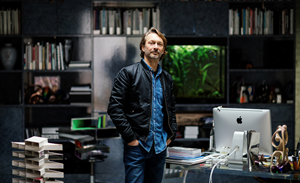
Anselm Reyle is undoubtedly one of the most established contemporary artists. Known primarily for his impressive ‘foil paintings’, Reyle’s recognisable visual language consists of primarily found objects in recontextualised and/or visually altered situations combined with glass and paint.
Anselm Reyle is undoubtedly one of the most established contemporary artists. Known primarily for his impressive ‘foil paintings’, Reyle’s recognisable visual language consists of primarily found objects in recontextualised and/or visually altered situations combined with glass and paint. On an autumn evening, I had the luck to be given a private tour through his big atelier near Treptower Park and learn more about the large-scale works that have always fascinated me with their shiny surfaces and vibrant colours.
 Installationsansicht Ruinengarten Anselm Reyle & Tanja Lincke, 2019. ©Matthias Kolb; Courtesy of Studio Anselm Reyle
Installationsansicht Ruinengarten Anselm Reyle & Tanja Lincke, 2019. ©Matthias Kolb; Courtesy of Studio Anselm Reyle
Behind the large front gate, a large garden with the atelier complex awaits us. The high-ceilinged atelier compartment lies by the water and the calm ambience contributes to the delicate atmosphere that one needs to absorb all the various elements in Reyle’s works.
In the first room, the most recent large-scale paintings lie on large tables facing the ceiling. A thick burlap canvas with iridescent foil and rough colour surfaces immediately grabs the attention. The style has changed and yet, the visual language of the artist remains recognisable. The work is an interplay between the freedom of spontaneity and the precision of experience. Some details appear to be spontaneous, but yet they serve an important role for the final visual output of the work. The colours and techniques remain in dialogue. The trademark material foil is also present. It is fascinating how the foil changes shades depending on the angle of the viewer, and its ability to reflect the colours in the room and the canvas itself.
 Untitled, 2021, mixed media on burlap, 170 x 145 x 8 cm, ©Matthias Kolb; Courtesy of Studio Anselm Reyle
Untitled, 2021, mixed media on burlap, 170 x 145 x 8 cm, ©Matthias Kolb; Courtesy of Studio Anselm Reyle
Around on the walls, smaller studies of the larger paintings are hanging or are stacked on high shelf racks. When asked why he hasn’t exhibited those so far, he says ‘I don’t exhibit something before I am sure it’s ready to be exhibited. It has to represent the final complete painting as close as possible’.
Found materials, shiny things, aluminium foil, kitschy’ items, like small African sculptures one can find in the flea market hold an inner fascination which he then takes as inspiration for larger scale works. He is inspired by their motifs, shapes and patterns and they constitute the foundation on which he develops completely new work. Combining contradictory elements in unexpected ways is also a common practise in the work.
As abstract as it may look, Reyle is very interested in the materiality of painting; coming from a painting background, he immediately creates associations between painterly elements and flashy objects and how they can be integrated on the painting without losing their materiality. While talking about this, Reyle makes an interesting statement: ‘In a way I am a classical painter. In my work, I am very interested in all the classical aspects of painting: colour, form, dynamic, composition and light’. This all comes to be manifested in the contrasting elements and complementary colour pairs that he is using.
In the next room, an amazing collection of works from different series awaits us. A combination of sculptures and wall pieces. Three large-scale foil paintings are hanging. Large and imposing, and yet with some fragility attached to their ontology, the works are excellent examples of the artistic identity of Reyle: the dialogue between found and invented, the game between painterly abstraction and object materiality. Behind acrylic glass, metal counterparts or purple foil can be seen. Some works are additionally made with neon tubes inside.
 Untitled, 2009, mixed media oncanvas, acrylic glass 143 x 122 x 20 cm, ©Matthias Kolb; Courtesy of Studio Anselm Reyle
Untitled, 2009, mixed media oncanvas, acrylic glass 143 x 122 x 20 cm, ©Matthias Kolb; Courtesy of Studio Anselm Reyle
What do the foil images mean to the artist? ‘The foil images represent to some extent also a sign of our consumer society. We love consuming shiny things, while in the case of art, there is still this taboo existing that it shouldn’t be ‘too decorative’. These works are for me a way to break the taboo. The decorative aspect has always been part of the visual arts and always will be’, he says.
And what about the ceramic sculptures? ‘I am often fascinated by the materials themselves and not necessarily in their perfect form but rather in their imperfections. In case of the large ceramic vases, for example, it is the ‘flaw’ created by the crack on the otherwise perfectly polished surface that makes it interesting for me. Spontaneity plays a crucial role here. It is the observation of how an object can so easily loose its functionality and become something else that excites me in regard of these sculptures’, he concluded.

ArtDependence Magazine is an international magazine covering all spheres of contemporary art, as well as modern and classical art.
ArtDependence features the latest art news, highlighting interviews with today’s most influential artists, galleries, curators, collectors, fair directors and individuals at the axis of the arts.
The magazine also covers series of articles and reviews on critical art events, new publications and other foremost happenings in the art world.
If you would like to submit events or editorial content to ArtDependence Magazine, please feel free to reach the magazine via the contact page.